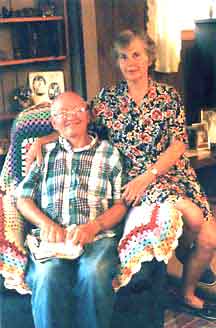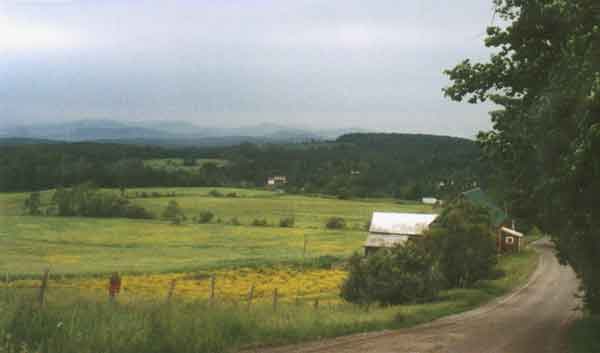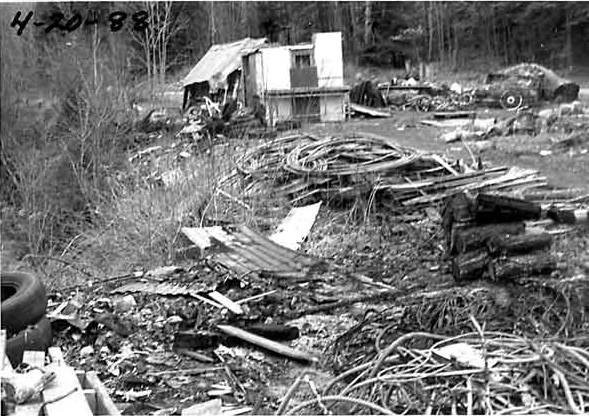Plainfield Puzzle:
Deadly Disease Strikes Vermont Town
Is a cluster of Lou Gehrig's Disease cases cause for alarm
It was a tip from a local physician that led Melanie Lawrence, then a medical student at the University of Vermont, to undertake a study of an unusual incidence of Lou Gehrig’s disease in Plainfield. A year and a half later, Lawrence came forth with a report showing that people in the small central Vermont community have a 10 times higher risk of getting amyotrophic lateral sclerosis, or ALS, than those in the rest of the nation.
 |
|
| The Potters |
In the last 30 years, at least six of the town’s 1300 longtime residents contracted the lethal neurological illness — four in the 1990s. A seventh case is suspected but unconfirmed. All lived for more than 20 years within a five-square-mile area in beautiful hills that may hide clues to what causes the disease.
Medical experts warn against alarm, since “hot spots” can occur by chance alone. But researchers are justifiably intrigued. “Any epidemiologist worth his salt is looking for clusters,” says University of Wisconsin-based ALS expert Benjamin Brooks, noting a concentration of cases can help isolate possible causes. For example, it was only after an Australian obstetrician delivered three infants with stunted or missing limbs that he realized their mothers had all taken thalidomide during pregnancy.
| His face still breaks easily into the endearing grin of the younger man who hunted, fished and worked the land he grew up on. |
According to a survey, ALS is the diagnosis doctors most dread delivering. It is not only a death sentence, but a guarantee of inexorable deterioration, usually within a few years. While the mind and senses remain acute, the body sheds, one by one, the abilities to walk, move, talk, eat, swallow and, finally, breathe. At that point, only 10 percent of patients choose to extend their lives with a respirator. There is no cure, effective treatment or even an explanation for why about 1.5 people in 100,000 are stricken in the U.S. every year.
Lawrence set out to discover why Plainfield had an incidence rate of 15 per 100,000. That meant investigating what linked the cases, and what distinguishes Plainfield from the rest of the state. She looked to a body of sometimes conflicting research that points to, but does not prove, hereditary predisposition triggered by environmental toxins and workplace exposures.
 |
|
| The view from near the Potters' house in Plainfield. |
Raymond Potter is the only one of the six confirmed cases in Plainfield who is still alive. “He was the guy that would help everyone,” says his doctor, John Matthew, a general practitioner at the local health center. When Albert Griggs — another member of the cluster — was dying, Potter often helped care for his old friend and neighbor, little suspecting that a year later, he too would be diagnosed with ALS.
Potter, 66, lives with his wife and childhood sweetheart Leatrice surrounded by the memorabilia from 43 years of family life. His face still breaks easily into the endearing grin of the younger man who hunted, fished and worked the land he grew up on. Walking with difficulty and no longer able to talk, he communicates by writing with a pencil clutched in a hand calloused by decades of labor.
| Lawrence concluded there was less than a 1 in 40,000 chance that the Vermont “hot spot” is a random occurrence. |
After Potter was diagnosed about three years ago, hundreds of his friends and neighbors attended a benefit at the local high school to support him and raise money for ALS research. A few people attending the bittersweet evening noted that there seemed to be quite a few cases in the neighborhood.
Reggie and Gordie Holt, whose cousin died of ALS, drew up a list and gave it to Reggie’s wife Connie, a nurse. “Oh, my gosh, that’s weird,” she said. She then told Matthew, who, after 27 years in the community, takes a deeply personal as well as professional interest in the patients in the six towns his clinic serves. Matthew contacted the Univer-sity of Vermont.
That’s when Lawrence, in search of a research project, volunteered to investigate. A former dairy farmer and mother of two, she began medical school at age 35 and got her MD this spring. “I thought it would make an interesting little project,” she says. “Boy, was I wrong.”
After poring through medical and death records and interviewing dozens of people, Lawrence presented her results. Although she has not yet identified a unifying link between the Plainfield cases, except geography and age, some of the patients did experience risk factors associated with ALS. These included exposure to pesticides, heavy metals, electric shocks and broken bones. After consultation with the state health department and university experts, Lawrence concluded there was less than a 1 in 40,000 chance that the Vermont “hot spot” is a random occurrence.
No one knows how many clusters exist throughout the country. Each of the nationally known researchers interviewed for this article mentioned possible clusters that the others had not heard of. “Because the U.S. doesn’t have a national reporting system or registry,” laments Matthew, there is no way to check how many hot spots there are. “We miss many things of significance that might prove relevant in diagnosis and prevention.”
According to Patty Krusinski, study coordinator for the Vermont ALS Center, “There is another possible cluster of five people with active ALS in northern New England with the same population, but [with] a radius a little larger geographically than Melanie’s.”
Some other provocative groupings include three members of the same San Francisco ’49ers football team who developed ALS in the 1980s; 22 men who served in the Canadian Navy out of Halifax in the 1950s, and died of the disease at a rate more than 50 times the national average; and two firefighters exposed to a 1978 chemical fire in Philadelphia, who died of ALS within 14 months of each other. But there is no way to know if these and other suggestive hot spots around the country add up to a pattern.
Researchers have been able to document that certain occupations seem to have a higher incidence of ALS: airline pilots and navigators, who are exposed to strong electromagnetic fields; athletes and others with a lifetime of strenuous physical activity; military personnel; welders; and dairy farmers, who are exposed to multiple factors, including shocks from fences and stray electricity from equipment, pesticides and lead fumes from farm equipment. High exposure to agricultural chemicals almost triples the risk for men, while dairy farming quadruples the risk, according to Lawrence’s research.
Potter and Griggs, who lived about a mile away and died of ALS in 1996, were dairy farmers at various times, as was one other member of the Plainfield cluster. Potter worked on Griggs’ farm occasionally as a teenager, as well as on the farm of another Plainfield dairyman who died of ALS prior to the 30-year span covered in Lawrence’s study.
The search for causes of ALS is made more difficult by the fact that it can take decades for neurodegenerative diseases to develop after exposure to triggering toxins. The noxious fires that the Griggs’ closest neighbor set throughout the 1980s have long since gone out, but Griggs’ widow Ondree and their daughter Darlene Covey now wonder if the clouds of acrid smoke that hung over their land damaged the family’s health.
So does Lawrence. In her study, she cites the burning as one of the “areas of interest [that] warrant further study” and reported that neighbors experienced “symptoms of headache and sore throat when the burning occurred.”
 |
Lund's junk pile across from the Potters. (Vt. Environmental Dept. photo) |
The fires were burned by Webster Lund, a salvager who lived across the road. He torched 50-foot-long hillocks of tires and great piles of wire and cable to remove the rubber and plastic coating from the saleable copper. In 1984, when asked by state environmental analyst Philip Etter how long he had been burning, Lund answered, “two weeks… plus 20 years,” and promised to stop. Four years later, after fines and warnings failed to deter Lund, Etter requested criminal prosecution.
“The burning of plastic and rubber wire coatings, garbage and tires releases large amounts of toxic gases, which may be hazardous to the health of nearby residents,” Etter wrote. Lund got off with a suspended sentence and reportedly continued his activities. He died in 1991 of lung cancer.
“Any time you are burning stuff like that,” says Etter, “there are probably hundreds of different air contaminants that come off,” including dioxins, cyanide, PCBs and chlorine.
Lund was not the only local polluter. During hard times in rural Vermont, some people on the edge scraped by in ways that were less than legal or environmentally sound. Another neighbor reportedly burned cable and hauled away electrical company transformers laden with PCBs — he broke them up on his land to salvage the metal. This kind of pollution adds up. The EPA has long cited open burning as a significant source of dioxin contamination.
Ondree Griggs is also curious about the effect of Albert’s military service. One of the first Americans in Hiroshima immediately after the U.S. dropped the atom bomb, her husband operated a bulldozer to bury the radiation-charred bodies of the Japanese victims.
Some studies have linked military service to higher risk of ALS. So far, 28 Gulf War veterans have been diagnosed with ALS, with a dozen more suspected cases. Although the rate of confirmed cases is not unusual, it may represent only the first victims of the disease. Official numbers may be further skewed downward because not all vets use the Veterans Administration medical system and some VA doctors reportedly collaborate with patients to misreport the diagnosis as “unknown.” Since ALS is not considered a service-related illness, sufferers do not receive full benefits.
Also surprising about the 28 Gulf War vets is their average age: 35, compared to the mid-fifties, when ALS usually manifests itself. “Relatively early age of death may be a clue that an environmental factor is in-volved,” the American Journal of Health noted in 1996. The likelihood of someone in his or her thirties getting sporadic ALS has been estimated between one to two in a million, according to various studies.
| Some studies have linked military service to higher risk of ALS. So far, 28 Gulf War veterans have been diagnosed with ALS, with a dozen more suspected cases. |
Those odds may be changing. In the last five years, clinicians and researchers have noted that ALS victims appear to be significantly younger. They wonder if the vets are part of this trend, or are dying young because of Gulf War exposure to chemical and petroleum fires, nerve gas, pesticides, vaccines and radiation from depleted uranium rounds.
Melanie Lawrence, who just entered the Dartmouth residency program, doesn’t expect her study to solve the mystery of ALS, but hopes it will add a piece to the puzzle and spur further investigation into the Plainfield cluster.
In response to Lawrence’s findings, Vermont Commissioner of Health Jan Carney convened a meeting last week at the health department to discuss what action, if any, to take. “Lawrence’s study is very interesting and raises questions in terms of an apparent cluster,” she said, “but doesn’t answer questions. My first priority is to look at this not from a research perspective but from a practical public health perspective and decide what information would be helpful.”
“We should get as much information as possible about what people were exposed to,” says Freya Kamel, an epidemiologist with the National Institute of Environmental Health who authored a study linking lead exposure to increased risk of ALS. “Even though it won’t help those already sick,” she says, “it can identify potential risk factors and we may be able to make some progress in preventing the disease.”
For now, the Potters are less concerned about finding why Raymond got sick than in finding pleasure in their remaining time together. A month after doctors gave them the dreadful news, the couple took off to Canada on a long motorcycle trip, like those they had enjoyed throughout their marriage. “It was sad,” says Leatrice. “We would be going down the highway and tears would be coming down from our eyes. But we have memories that can’t be taken away.” •
Gulf War vets experiencing neurological symptoms are urged to call toll-free 1-877-DIAL-ALS to participate in a study.
| . |
| . |
| . |
| . |
| . |
| . |